Recording technology continues to leap forward, but in the wake of these new found ways to enjoy music, looking back on older sound formats is a true time machine. We can easily put ourselves into the mood of that era by listening to tracks on their original recorded form. There wasn't perfection in the recordings but a full sense of atmosphere.
Garage Band, Pro Tolls and Audition make for great sound editing programs but at the same time they get over used and bands forget that its all about the song. Imperfections are part of human nature and the world around us. Pop perfection is for those who need to fill up their agenda sheet. Go for substance and longevity in your music. The fans are there, now make them believers.
Link to original article on Collectors Weekly
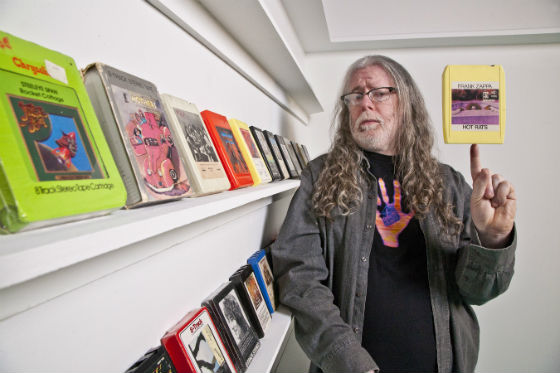
But that hasn’t stopped Burnett from becoming the eight-track’s most vocal champion, amassing an incredible collection of Stereo 8 cartridges, and opening the world’s first museum devoted entirely to the format. Located in the Deep Ellum neighborhood of Dallas, Texas, Burnett’s original Eight Track Museum opened in 2011, offering visitors a peek at an often overlooked medium plus an archive of every audio recording format created since the earliest wax cylinders of the late 1800s. In October of this year, the second outpost of Burnett’s homage to the 8-track opened at the Orphic Gallery in Roxbury, New York, expanding the reach of his crusade for lesser-known forms of audio recording.
Burnett recently gave Collectors Weekly the down-low on forgotten formats and why the world needs a few museums dedicated to Stereo 8.
Burnett: No, I didn’t. I listened to them at friends’ houses and they were always around in music stores, but I was focused on LPs and 45s when I was really young. When I was able to drive, I got a cassette player in my car instead, but at the time I was managing the eight-track department at Peaches Records in Dallas, so it was kind of ironic.
Burnett: In 1988, I was at a garage sale in Dallas, looking through a box of stuff, and I found the Beatles’ “White Album” on eight-track, which was a two-tape set in this lovely black slip case I’d never seen before, with “The Beatles” written in gold lettering. I thought, wow, that’s cool. I asked the guy, “How much for this?” and he said, “Seven dollars.” I said, “For an eight-track?” thinking, “Are you nuts?” And he said, “Give me the seven or put it back in the box.” So I gave him the seven bucks, and that’s how it all started.
I took it home that day and put it up on my fireplace mantel, and it kept catching my eye for the next two or three days. By 1988, eight-tracks had been over for several years so it looked very exotic to me. Then I got this terrific idea to collect every single Beatles eight-track, and that took five years because this was pre-Internet. I had to go to estate sales, garage sales, thrift stores, and flea markets to find them.
I started putting the extra ones out for sale at my record store as a joke, because by 1989 or ’90, the last thing you needed in your record store was an eight-track section, right? Well, much to my shock, they were selling as fast as I could put them out to people who didn’t even have players. That’s when I realized there was this larger interest.
Burnett: Well, they couldn’t
be more different. The Dallas location is considered the mothership.
That’s where I have the master collection of, say, 3,000 of the best
eight-tracks ever made, plus 5 or 10 of the worst. The Roxbury location
is more about the hardware. In the Roxbury museum, we’ve constructed a
physical walk-through timeline of most major formats throughout the last
120 years or so, from the wax cylinder of the 1870s on up through the
iPod. They’re all in perfect working order, so we can demonstrate how a
wax cylinder, 78 player, eight-track, or reel-to-reel sounds. We provide
that as a sort of public service to really give people a visual and
audio education of what music has sounded like throughout the decades.
The Roxbury site also has the world’s absolute guaranteed rarest eight-track. It’s a Frank Sinatra album recorded with the Brazilian jazz musician Antônio Carlos Jobim called “Sinatra/Jobim.” The album was briefly issued on eight-track but recalled before any LP or cassette copies were made, and only about 5 copies survived because Frank ordered them to be destroyed. I think somebody put five into their pocket and took them home. They generally change hands for around $5,000. We miraculously got one of those for the museum, and we’re very proud that it’s on display right now in Roxbury. In fact, it even has its own room. I thought it would be great to accent its specialness and rarity by having it be the only tape in a small room.
Burnett: In the mid-’60s, Bill Lear of Learjet wanted a format to play music in his airplanes, so he had his engineers develop a tape cartridge that they installed in the jets. Very quickly a light went off in his head. He’s like, “Wait, my jet customers love having music in the air. Why can’t I put this in cars?” Lear went out and lobbied all the big auto manufacturers in Detroit and got them to introduce a line of eight-track players in their 1966 cars. The very first eight-tracks appeared in the marketplace in 1965 for the ’66 cars. To put it in context, the first Beatles eight-track offered as a new release was “Rubber Soul.”
What’s cool, though, is that if you bought an 8-track player for your car, from the very first year each car manufacturer gave you a free eight-track. It was like “Ford presents the swinging sounds of ’66,” and each company would do a new one every year. The music was a pretty safe selection of greatest hits of the day that wouldn’t offend anybody. I don’t think the Sex Pistols ever ended up on one.
A lot of car collectors also collect those eight-tracks, and there are more than 100 of them since you had seven or eight major carmakers putting out a different eight-track every year. I have a big stack of Cadillac eight-tracks.
Burnett: Very few people are ever going to understand this, but it’s shockingly good. It depends on the player. If you’re going to play an eight-track in one of those little $30 take-it-to-the-beach portables, it’s going to sound cheap. But they also made a lot of nice units, and with the right unit in the car or at home with the right speakers, they had this incredible, gigantic, beautiful analog sound.
Burnett: It’s hard to convince people who weren’t around then, but
the eight-track was nothing less than revolutionary in the context of
its time. It was the first time that you didn’t have to listen to what
was on the radio if you didn’t want to. You could listen to the Beatles
or Led Zeppelin or Hank Williams.
For the first time, the consumer and the driver had complete control over what he was going to listen to. What that did was inspire further innovation and marketing possibilities. They finally introduced a home player for the eight-track in 1968 (it was car-only for about two years). Then the home players took off. People were listening to them at home and in the car. And then they introduced the recording eight-track deck, so that you could make a mix tape at home on eight-track. You could buy a new Led Zeppelin LP plus a blank eight-track tape for a buck, and then throw the album on the tape. That way you’d have the album for home and the tape for the car.
There were also these little, tiny tapes made from ’65 through 1970 called two-tracks. They’re half the size and half the depth of the eight-track, and they’re just adorable. Almost every Beatles album came out in a series of two-tracks, as did albums by Frank Zappa and other rock artists, and now they’re really collectible. No one even knew about two-tracks when they were new. Also, the very first cassettes were like five times the size of the cassette we think of. So there are just dozens and dozens of great examples.
I’ve had a few hundred people come through my doors and they’re typically divided into two groups: Half are nostalgic and want to relive some memories. The other half are into discovery, and they want to see a type of museum they haven’t seen before, or they buy LPs but want to know what came before that. So it’s halfway between nostalgia and discovery.
Collectors Weekly: Is there anyone making new eight-tracks today?
Burnett: Me! I have an eight-track label called Cloud 8 Music, and that’s also the name of my small chain of record stores in Dallas. Once or twice a year, we’ll put out eight-tracks with local or national artists and we’ll have a release party in the museum. I put out very limited editions, like the Tom Tom Club album on eight-track released last year. Chris Frantz and Tina Weymouth came to the museum and signed all of them, and we sold them out in the middle of the night.
Collectors Weekly: Are you working on any future projects involving the eight-track?
Burnett: I’m currently producing a documentary about the eight-track called “Spinal Tape.” We’ve already filmed about 40 rock-star interviews, including Jimmy Page, all four Talking Heads, Tiny Tim, and two of the Small Faces, so it’s going to be an amazing collection of rock stars all in one documentary. Other than that, my next goal is to open an eight-track museum somewhere in England.
Garage Band, Pro Tolls and Audition make for great sound editing programs but at the same time they get over used and bands forget that its all about the song. Imperfections are part of human nature and the world around us. Pop perfection is for those who need to fill up their agenda sheet. Go for substance and longevity in your music. The fans are there, now make them believers.
Link to original article on Collectors Weekly

"Growing up in the 1970s, Bucks Burnett never even owned an eight-track tape: When his parents purchased their first post-LP stereo console, they went straight for a cassette player. “They were visionaries,” he says.
“The eight-track was nothing less than revolutionary in the context of its time.”Burnett’s obsession with Stereo 8 tapes began after a chance encounter at a garage sale in the ’80s, and he’s never looked back. The quirky vibe of each Eight Track Museum is perfectly matched by Burnett’s outsized personality (when the Oxford English Dictionary decided to remove the entry for “Cassette Tape” in 2011, Burnett retaliated by banning the dictionary from his museum). During the ’80s, Burnett befriended such music world notables as the ukelele-playing Tiny Tim, as well as Chris Frantz and Tina Weymouth, the founding members of the Talking Heads who went on to create Tom Tom Club in 1981. Among others, each of these stars is a part of Burnett’s unfinished documentary on the 8-track tape, called “Spinal Tape,” which is expected to be completed in 2013.
Burnett recently gave Collectors Weekly the down-low on forgotten formats and why the world needs a few museums dedicated to Stereo 8.
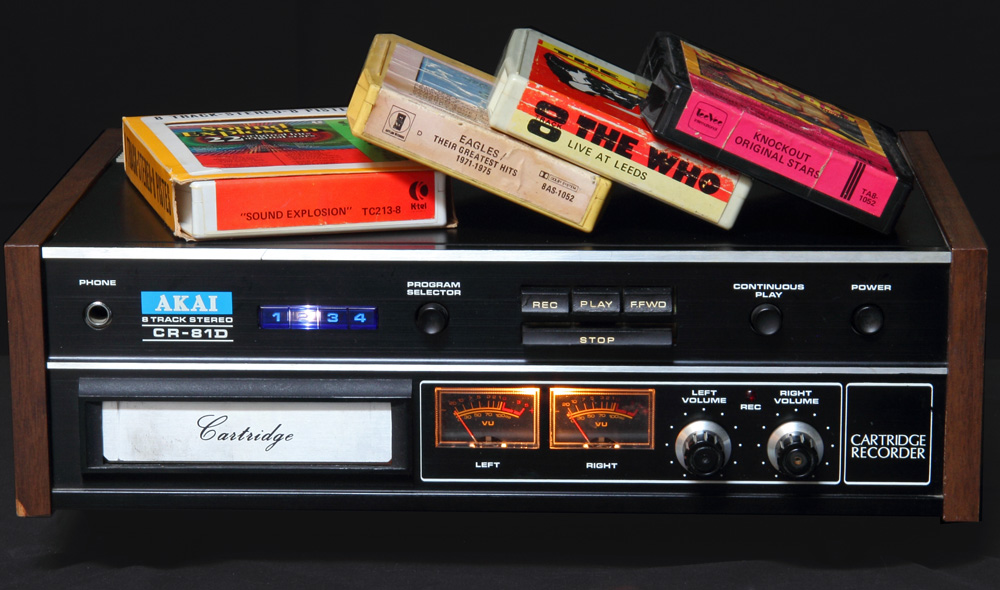 |
| Top: Bucks Burnett with a Frank Zappa tape in his Dallas museum. Above: An Akai CR-81D 8-track player with tapes. Via iavscanada.com |
Collectors Weekly: You never owned a single 8-track tape as a kid?
Collectors Weekly: Do you associate them with specific music?
Burnett: Mainly Led Zeppelin, because when you’d go driving around, partying, people would usually be playing Led Zeppelin eight-tracks.Collectors Weekly: When did you start collecting them?
 |
| The Beatles’ “White Album” eight-tracks got Burnett hooked on the format. |
Burnett: In 1988, I was at a garage sale in Dallas, looking through a box of stuff, and I found the Beatles’ “White Album” on eight-track, which was a two-tape set in this lovely black slip case I’d never seen before, with “The Beatles” written in gold lettering. I thought, wow, that’s cool. I asked the guy, “How much for this?” and he said, “Seven dollars.” I said, “For an eight-track?” thinking, “Are you nuts?” And he said, “Give me the seven or put it back in the box.” So I gave him the seven bucks, and that’s how it all started.
I took it home that day and put it up on my fireplace mantel, and it kept catching my eye for the next two or three days. By 1988, eight-tracks had been over for several years so it looked very exotic to me. Then I got this terrific idea to collect every single Beatles eight-track, and that took five years because this was pre-Internet. I had to go to estate sales, garage sales, thrift stores, and flea markets to find them.
Collectors Weekly: How many total Beatles releases were there?
Burnett: Including all the tacky reissues the company put out after the band broke up, about 25 or so. I was very dedicated.Collectors Weekly: Did this inspire you to create the museum?
Burnett: Well, I also owned a record store called 14 Records in Dallas at the time. All I was really doing was trying to build a complete Beatles eight-track set, but if you’re looking through a box and there’s Pink Floyd and Led Zeppelin for 50 cents each, you can’t say no. So I accidentally started collecting them and then six months later I’m like, “Wait a minute, I’ve got three copies of ‘Dark Side of the Moon’ here.”I started putting the extra ones out for sale at my record store as a joke, because by 1989 or ’90, the last thing you needed in your record store was an eight-track section, right? Well, much to my shock, they were selling as fast as I could put them out to people who didn’t even have players. That’s when I realized there was this larger interest.
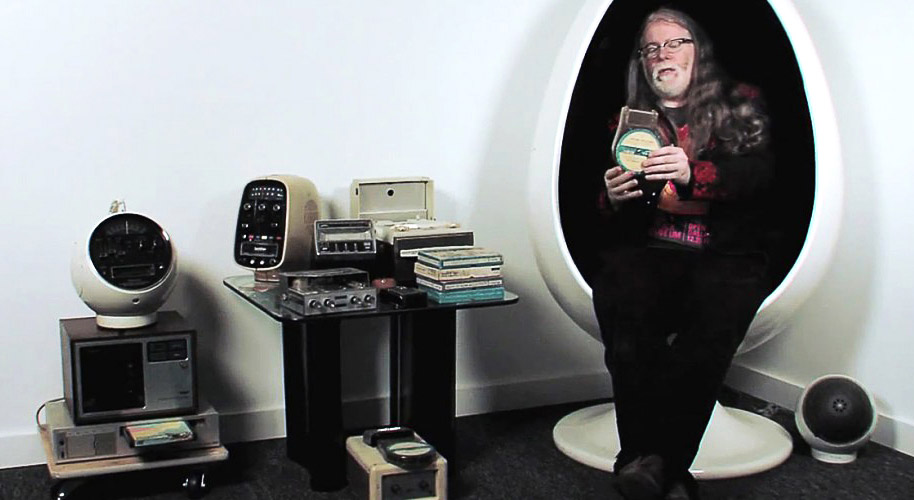 |
| Burnett shares a selection of historic audio formats at his Dallas museum. |
Collectors Weekly: Were people drawn to them as physical objects?
Burnett: Absolutely. That’s a huge part of it. If you think about it, of the dozens of formats over the last, say, 50 years, it’s the only one that’s self-contained. A cassette has like three, four, or five pieces and when you lose two pieces, you throw it away. Even for the beloved LP, you’ve got the record, the sleeve, and the cover. The eight-track tape was just one object. You shove it in, you pull it out, and it’s the exact size of your hand. I think people really responded to that.Collectors Weekly: What’s unique about the original Dallas museum versus the new Roxbury location?
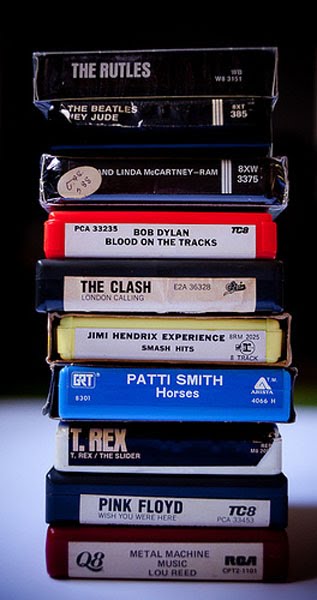 |
| A selection of eight-tracks from Bucks Burnett’s collection. Photo by Allison V. Smith. |
The Roxbury site also has the world’s absolute guaranteed rarest eight-track. It’s a Frank Sinatra album recorded with the Brazilian jazz musician Antônio Carlos Jobim called “Sinatra/Jobim.” The album was briefly issued on eight-track but recalled before any LP or cassette copies were made, and only about 5 copies survived because Frank ordered them to be destroyed. I think somebody put five into their pocket and took them home. They generally change hands for around $5,000. We miraculously got one of those for the museum, and we’re very proud that it’s on display right now in Roxbury. In fact, it even has its own room. I thought it would be great to accent its specialness and rarity by having it be the only tape in a small room.
Collectors Weekly: Like the crown jewel, so to speak.
Burnett: Yeah, there are about five other eight-tracks that over the past few years have sold in the same dollar range as the Sinatra album, but the Sinatra is the Mona Lisa. It’s an undeclared crown jewel, and I couldn’t be more thrilled to have it.Collectors Weekly: Have you actually listened to it?
Burnett: Oh, God, no. That would be just my luck, you know, I’d put it in, and there it goes. For 30 years, most of the music on that eight-track was unique to the eight-track, never reissued, and finally two years ago they put it out as part of a two-CD collection.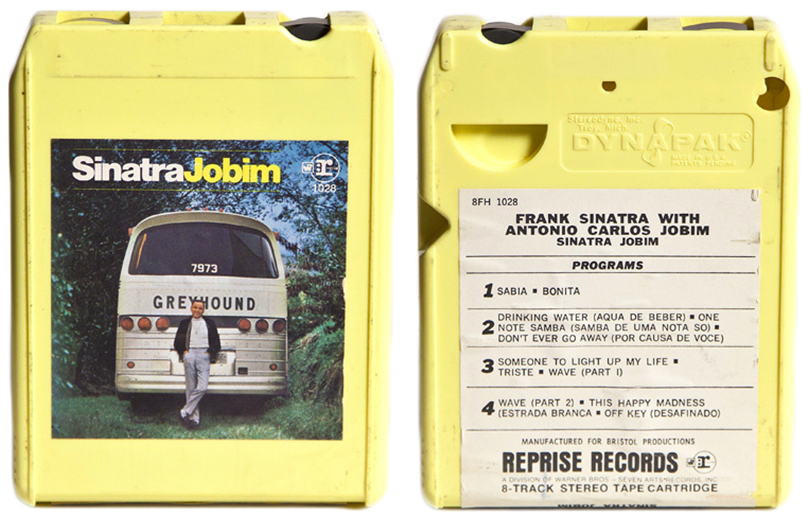 |
| The infamous “Sinatra/Jobim” album, now on view at the Roxbury, NY, location of the Eight Track Museum. Image courtesy Bucks Burnett. |
Collectors Weekly: How was the Stereo 8 format initially developed?
“If you’re looking through a box and there’s Pink Floyd and Led Zeppelin for 50 cents each, you can’t say no.”
A lot of car collectors also collect those eight-tracks, and there are more than 100 of them since you had seven or eight major carmakers putting out a different eight-track every year. I have a big stack of Cadillac eight-tracks.
Collectors Weekly: Were any other audio formats built into cars before that, like portable LP players?
Burnett: Yes, there were, but they just had too many problems. No matter how hard they tried, the records just skipped constantly. They tried making the tone arm heavier, but a bump is a bump; it wasn’t contained enough for the playing to be successful. They never really caught on, but there’s video of people playing turntables in cars, a very short lived but fascinating development along the way. The eight-track was truly the first mass-consumer car format. |
| A 1960s advertisement for the Lear Stereo 8 automobile player. |
Collectors Weekly: What do you think about the audio quality of 8-tracks?
Collectors Weekly: Why do you think it was such a short-lived medium?
Burnett: That’s actually a misconception—it was not short lived. They were introduced in 1965, and sold in retail through 1982. They continued to be sold through mail-order music clubs through 1988, meaning the eight-track format survived for 23 years.Collectors Weekly: What kind of effect did the eight-track have on audio technology?
 |
| A ’70s-era ad for portable players shows the eight-track’s evolution from car-stereo to home use. |
For the first time, the consumer and the driver had complete control over what he was going to listen to. What that did was inspire further innovation and marketing possibilities. They finally introduced a home player for the eight-track in 1968 (it was car-only for about two years). Then the home players took off. People were listening to them at home and in the car. And then they introduced the recording eight-track deck, so that you could make a mix tape at home on eight-track. You could buy a new Led Zeppelin LP plus a blank eight-track tape for a buck, and then throw the album on the tape. That way you’d have the album for home and the tape for the car.
Collectors Weekly: Why do you think the cassette tape took over?
Burnett: It was smaller, and it had fewer issues. The eight-track had a few technical flaws that would create operational problems, it was well known for that. Which is too bad because the sound was really terrific. Eight-tracks sounded much better than cassettes.Collectors Weekly: Are there any particularly strange audio formats in your collection?
Burnett: Oh, yeah. I keep thinking I’ve discovered the last one, and then I find some other oddball. There was a folding eight-track manufactured briefly in 1970 that’s quite collectible now. The cartridge literally folds in half so you could put it in your shirt pocket. Those are insanely rare.There were also these little, tiny tapes made from ’65 through 1970 called two-tracks. They’re half the size and half the depth of the eight-track, and they’re just adorable. Almost every Beatles album came out in a series of two-tracks, as did albums by Frank Zappa and other rock artists, and now they’re really collectible. No one even knew about two-tracks when they were new. Also, the very first cassettes were like five times the size of the cassette we think of. So there are just dozens and dozens of great examples.
Collectors Weekly: What’s been the public response to the museums?
Burnett: Well, I would say it’s mild interest, but it’s interest. And we understand what we’re up against. We’re not expecting this to put the Guggenheim out of business anytime soon.I’ve had a few hundred people come through my doors and they’re typically divided into two groups: Half are nostalgic and want to relive some memories. The other half are into discovery, and they want to see a type of museum they haven’t seen before, or they buy LPs but want to know what came before that. So it’s halfway between nostalgia and discovery.
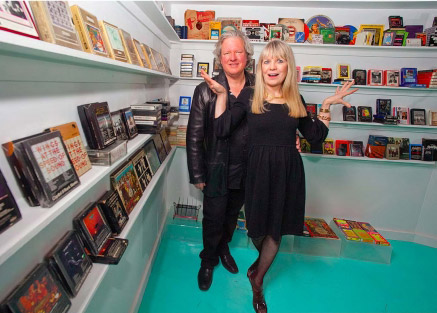 |
| Chris Frantz and Tina Weymouth at the Dallas Eight Track Museum opening in 2011. Photo by Dan Hurley. |
Burnett: Me! I have an eight-track label called Cloud 8 Music, and that’s also the name of my small chain of record stores in Dallas. Once or twice a year, we’ll put out eight-tracks with local or national artists and we’ll have a release party in the museum. I put out very limited editions, like the Tom Tom Club album on eight-track released last year. Chris Frantz and Tina Weymouth came to the museum and signed all of them, and we sold them out in the middle of the night.
Collectors Weekly: Are you working on any future projects involving the eight-track?
Burnett: I’m currently producing a documentary about the eight-track called “Spinal Tape.” We’ve already filmed about 40 rock-star interviews, including Jimmy Page, all four Talking Heads, Tiny Tim, and two of the Small Faces, so it’s going to be an amazing collection of rock stars all in one documentary. Other than that, my next goal is to open an eight-track museum somewhere in England.
Take a guided tour of Bucks Burnett’s Eight Track Museum below:"

